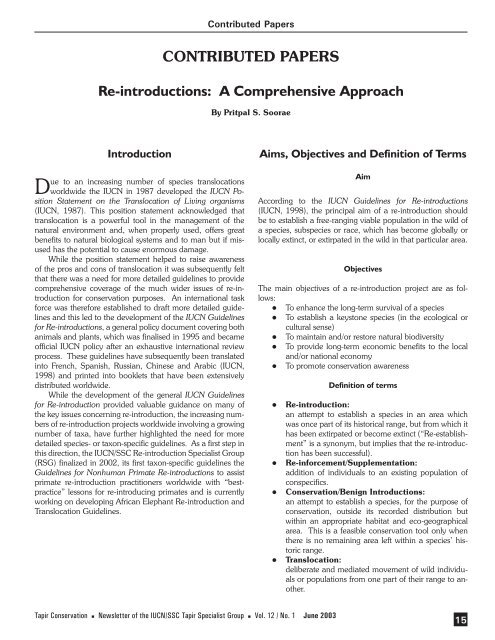Download now - Tapir Specialist Group
Download now - Tapir Specialist Group
Download now - Tapir Specialist Group
You also want an ePaper? Increase the reach of your titles
YUMPU automatically turns print PDFs into web optimized ePapers that Google loves.
Introduction<br />
Due to an increasing number of species translocations<br />
worldwide the IUCN in 1987 developed the IUCN Position<br />
Statement on the Translocation of Living organisms<br />
(IUCN, 1987). This position statement ack<strong>now</strong>ledged that<br />
translocation is a powerful tool in the management of the<br />
natural environment and, when properly used, offers great<br />
benefits to natural biological systems and to man but if misused<br />
has the potential to cause enormous damage.<br />
While the position statement helped to raise awareness<br />
of the pros and cons of translocation it was subsequently felt<br />
that there was a need for more detailed guidelines to provide<br />
comprehensive coverage of the much wider issues of re-introduction<br />
for conservation purposes. An international task<br />
force was therefore established to draft more detailed guidelines<br />
and this led to the development of the IUCN Guidelines<br />
for Re-introductions, a general policy document covering both<br />
animals and plants, which was finalised in 1995 and became<br />
official IUCN policy after an exhaustive international review<br />
process. These guidelines have subsequently been translated<br />
into French, Spanish, Russian, Chinese and Arabic (IUCN,<br />
1998) and printed into booklets that have been extensively<br />
distributed worldwide.<br />
While the development of the general IUCN Guidelines<br />
for Re-introduction provided valuable guidance on many of<br />
the key issues concerning re-introduction, the increasing numbers<br />
of re-introduction projects worldwide involving a growing<br />
number of taxa, have further highlighted the need for more<br />
detailed species- or taxon-specific guidelines. As a first step in<br />
this direction, the IUCN/SSC Re-introduction <strong>Specialist</strong> <strong>Group</strong><br />
(RSG) finalized in 2002, its first taxon-specific guidelines the<br />
Guidelines for Nonhuman Primate Re-introductions to assist<br />
primate re-introduction practitioners worldwide with “bestpractice”<br />
lessons for re-introducing primates and is currently<br />
working on developing African Elephant Re-introduction and<br />
Translocation Guidelines.<br />
Contributed Papers<br />
CONTRIBUTED PAPERS<br />
Re-introductions: A Comprehensive Approach<br />
By Pritpal S. Soorae<br />
<strong>Tapir</strong> Conservation n Newsletter of the IUCN/SSC <strong>Tapir</strong> <strong>Specialist</strong> <strong>Group</strong> n Vol. 12 / No. 1 June 2003<br />
Aims, Objectives and Definition of Terms<br />
Aim<br />
According to the IUCN Guidelines for Re-introductions<br />
(IUCN, 1998), the principal aim of a re-introduction should<br />
be to establish a free-ranging viable population in the wild of<br />
a species, subspecies or race, which has become globally or<br />
locally extinct, or extirpated in the wild in that particular area.<br />
Objectives<br />
The main objectives of a re-introduction project are as follows:<br />
l To enhance the long-term survival of a species<br />
l To establish a keystone species (in the ecological or<br />
cultural sense)<br />
l To maintain and/or restore natural biodiversity<br />
l To provide long-term economic benefits to the local<br />
and/or national economy<br />
l To promote conservation awareness<br />
Definition of terms<br />
l Re-introduction:<br />
an attempt to establish a species in an area which<br />
was once part of its historical range, but from which it<br />
has been extirpated or become extinct (“Re-establishment”<br />
is a synonym, but implies that the re-introduction<br />
has been successful).<br />
l Re-inforcement/Supplementation:<br />
addition of individuals to an existing population of<br />
conspecifics.<br />
l Conservation/Benign Introductions:<br />
an attempt to establish a species, for the purpose of<br />
conservation, outside its recorded distribution but<br />
within an appropriate habitat and eco-geographical<br />
area. This is a feasible conservation tool only when<br />
there is no remaining area left within a species’ historic<br />
range.<br />
l Translocation:<br />
deliberate and mediated movement of wild individuals<br />
or populations from one part of their range to another.<br />
15










